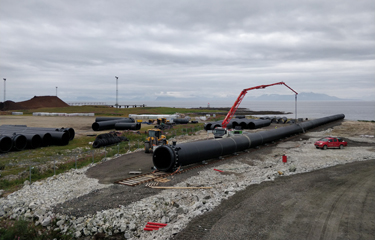Andfjord Salmon has announced plans to fast-track the second phase of its land-based salmon farming facility at Kvalnes, on the Norwegian Arctic island of Andøya.
The work will be carried out in parallel with its first phase of development of its flow-through facility, which will create a capacity of 1,000 metric tons (MT) maximum allowed biomass (MAB). Construction is now underway on its first ocean pool for salmon. The second phase of the project will expand overall grew-out capacity to 10,000 MT MAB, which is equivalent to a target production volume of 12,500 MT HOG (head on, gutted).
The farm’s innovative design is escape-proof, lice-free, and will use an automated cleaning system to maintain optimum conditions for the fish, according to a company press release.
Andfjord Salmon’s original intention had ben to release the first smolts into the start pool in spring 2021, but following news in July 2020 that Miami, Florida, U.S.A.-based recirculating aquaculture system farmer Atlantic Sapphire had been forced to harvest its fish early due to distress caused by nearby construction work, a decision was made to reassess and rework the development plan.
As a result, blasting and excavation work on the adjacent site for the second-stage pools has been brought forward by six months, and the transfer of smolts to the start pool delayed by six months.
“We are delighted to announce plans to fast-track the construction work at Kvalnes Phase 2. We are moving from a sequential development, to a parallel development of the full Kvalnes area. This will reduce overall project execution risk for the area development, and biological risk for the start pool,” Andfjord Salmon CEO Martin Rasmussen said.
In a press conference to announce the decision, Rasmussen said the parallel development will also save expenses related to de-mobilization and mobilization of construction machinery, and does not otherwise affect total cap-ex. Rasmussen reported that work on the first pool had progressed well throughout the autumn, with the final section of wall planned for installation this week. The water inlet and outlet pipelines are ready to be installed at the next available weather window.
“We are very satisfied with progress on the first pool, which is nearing completion,” Rasmussen said. “Another positive effect of our larger Kvalnes area development is that we get more time to test the first pool, which helps to further de-risk our technology.”
To secure funds for the fast-tracked development, Andfjord Salmon engaged ABG Sundal Collier and SpareBank 1 Markets as joint lead managers and bookrunners for an accelerated private placement of 2,100,000 new shares at a price of NOK 42.00 (USD 4.75) per share. The total raised was NOK 88.2 million (USD 10 million, EUR 8.2 million). The private placement attracted strong interest from existing shareholders in the company and high-quality institutional investors, according to a company statement.
Primary insiders who subscribed for and were allocated shares in the private placement were: UFI AS, allocated 125,000 shares and now holds a total of 1,642,097 shares; Skagerak Vekst AS, allocated 84,000 shares and now holds a total of 2,304,999 shares; Blue Marine Invest AS, allocated 50,000 shares and now holds a total of 1,410,735 shares; and OG Invest AS, allocated 23,800 shares and now holds a total of 1,123,800 shares.
Rasmussen said that in the third quarter of 2020, Andfjord Salmon had zero revenues compared to zero revenues in the same quarter last year. The company’s operating loss in Q3 was NOK 12.5 million (USD 1.4 million, EUR 1.2 million) versus a loss of NOK 5.4 million (USD 610,000, EUR 504,000) last year. Cash and deposits at the end of Q3 2020 were NOK 126.8 million (USD 14.3 million). The latter figure does not include a NOK 50 million (USD 5.7 million) undrawn credit facility with Sparebank 1 Nord-Norge and Innovation Norway. In addition, NOK 15 million (USD 1.7 million) in grants from Innovation Norway and Samskap are not included.
In the first six months of 2020, the company posted an operating loss of NOK 8.3 million (USD 936,000, EUR 785,000), compared to a NOK 5.1 million (USD 575,000, EUR 482,000) loss in the same period last year
Confident of its future, the company has already secured the rights for land at two more sites on the island, which would enable a potential expansion to a total capacity of 70,000 MT MAB, equivalent to a total production volume of approximately 90,000 MT HOG.
Separately, Rasmussen announced it will investigate secondary market sale of dried fish sludge, composed of fish faeces and uneaten fish feed, which will be continuously removed by cleaning robots. Recent research undertaken by the Norwegian Institute of Bioeconomy Research (NIBIO) found the sludge has the potential to be used as a component in products such as organic and organo-mineral fertilizers for agricultural and gardening use.
“Put plainly, we can make money from the salmon’s faeces," Rasmussen said. "To treat biological waste as a sustainable resource rather than a problem, has been a key objective for us. The NIBIO report confirms that this is possible, taking us one step closer to building the world’s most sustainable and fish-friendly aquaculture facility."
Photo courtesy of Andfjord Salmon







